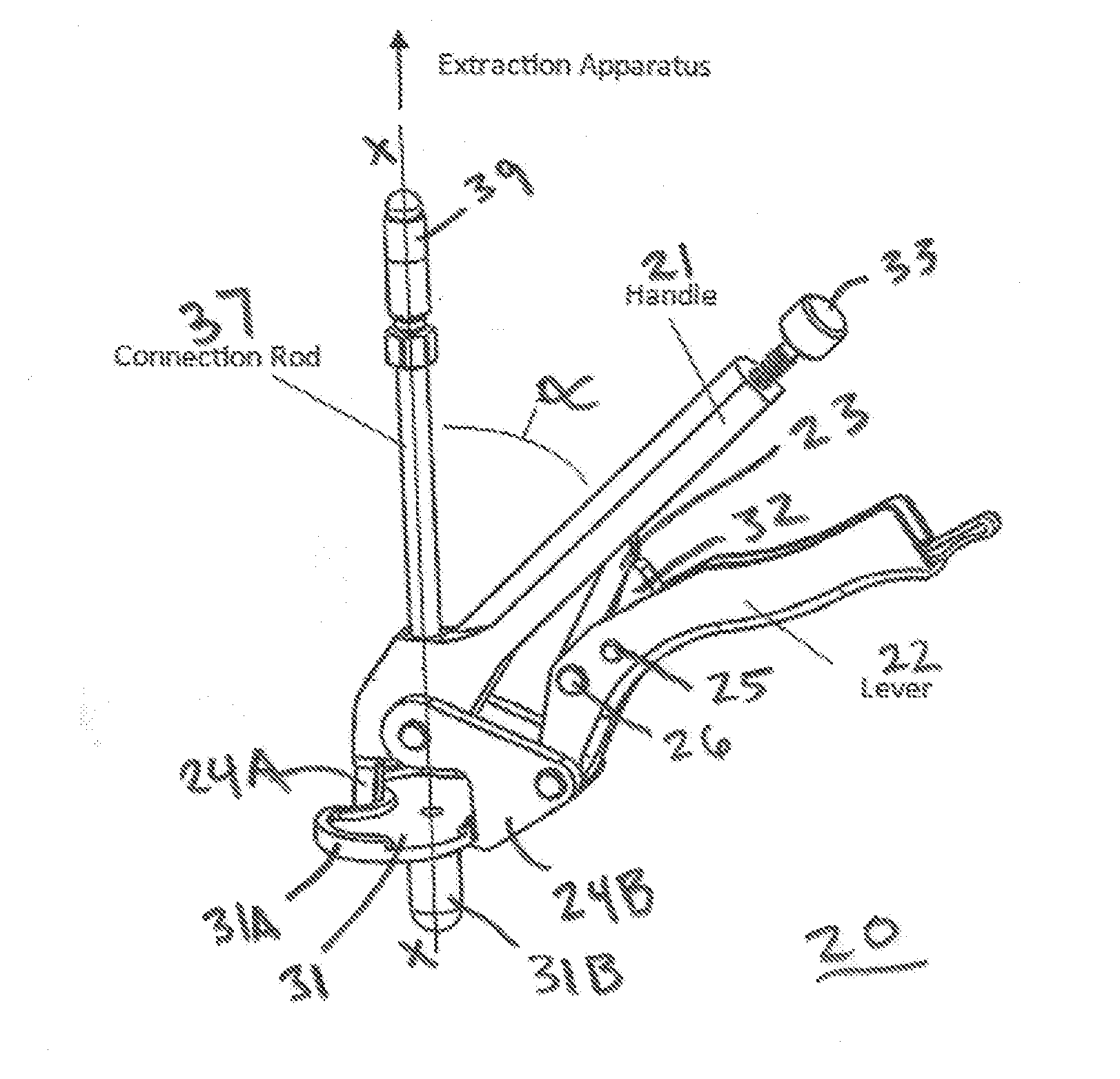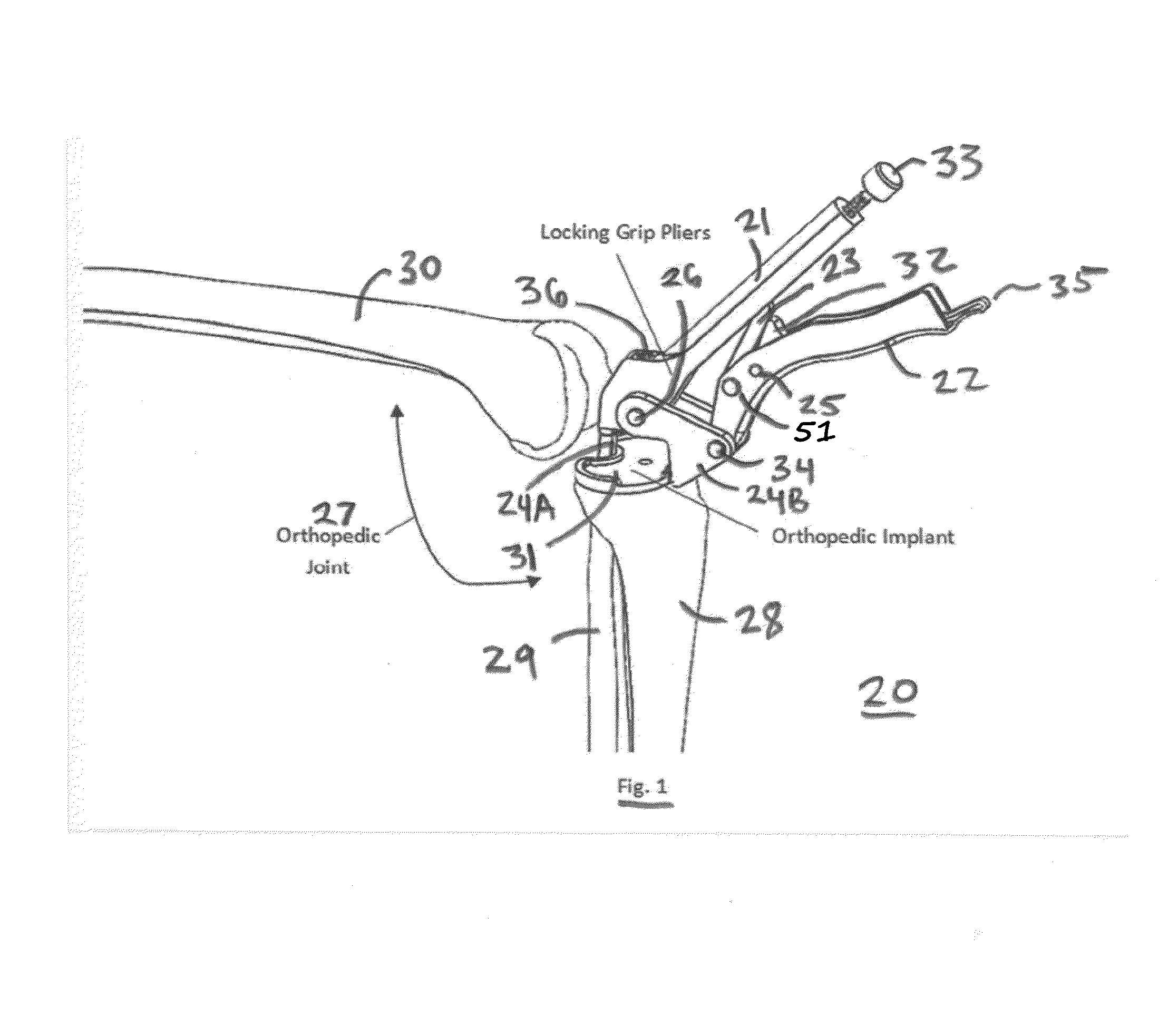Locking Grip Orthopedic Implant Extraction Tool
a technology of orthopedic implants and grips, applied in the field of locking grip orthopedic implant extraction tools, can solve the problems of difficult removal, inability to adequately grasp or hold the implant, and generally not suitable for other types of implants to be removed
- Summary
- Abstract
- Description
- Claims
- Application Information
AI Technical Summary
Benefits of technology
Problems solved by technology
Method used
Image
Examples
first embodiment
FIGS. 1 Through 4
[0028]As shown FIGS. 1 to 4 the locking grip pliers tool 20 has an upper handle21 and a more massive lower or gripping handle 22 joined to the upper handle by a locking link 23 which cooperates with the handles to provide a locking grip mechanism. A first jaw 24A is affixed to an implant gripping end of the handle 21, while a second jaw 24B is pivotably mounted to the adjacent end of the gripping handle 22 for rotation about the pins 34 and 26.
[0029]The knee joint 27 includes the proximal ends of the tibia 28 and fibula 29, and the distal end of the femur 30. A metal orthopedic implant 31 has a base or tray 31A and a stem 31B which is embedded in the truncated proximal end of the tibia 28. The jaws 24A and 24B engage, and have sharp edges which extend below opposite sides of the implant tray 31A.
[0030]The locking link 23 has one end mounted for rotation about the pin 51 in the gripping handle 22, while the other end is T-shaped and slidably installed in a longitudin...
second embodiment
FIGS. 5 to 8D
[0046]In the second embodiment shown in FIGS. 5 through 8D, the tool 50 has the same construction as the tool 20 of FIGS. 1 to 4, except that the jaws are replaceable.
[0047]Over a period of time the jaws of the tool 20 can become damaged by the repetitive action of the jaws piercing under the implant, in and out of bone cement and / or bone, so that the jaws need to be replaced. Jaw damage can also occur if the surgeon mistakenly causes the jaws to be rammed into the sides of the implant tray as shown in FIG. 5. The mechanical advantage of the tool can result in so large a force being applied to the jaws that they are bent out of shape. In either of these scenarios, replacement of the jaws is more cost effective than replacement of the entire tool.
[0048]A change of jaws is sometimes needed when a different type of implant needs to be removed. Such an implant type may have “augments” in which the tray of the implant is relatively thick, requiring jaws with an extended reac...
third embodiment
FIGS. 9 Through 13
[0052]During the operation of the tools 20 and 40 they are subjected to vibration due to repetitive impact force applied by the slap hammer or other extraction device, causing the gripping handle to pop loose.
[0053]To prevent such inadvertent release of the handles from their locked position, in the third embodiment the tool 45 adds a sliding rod 46 and a C-shaped detent 47. The rod 46 is mounted so that it can slide in a direction transverse to the handles 21 and 22 and act as a secure locking mechanism which, when engaged, prevents movement of the link relative to the gripping handle and thus securely locks the tool in its closed position.
[0054]When the secure locking mechanism is engaged by sliding the rod 46 so that its larger diameter portion 48 is retained in the undercut portion of the C-shaped detent 47, the locking link cannot move relative to the gripping handle and the handles therefore cannot move relative to each other; thus keeping the jaws firmly cla...
PUM
 Login to View More
Login to View More Abstract
Description
Claims
Application Information
 Login to View More
Login to View More - R&D
- Intellectual Property
- Life Sciences
- Materials
- Tech Scout
- Unparalleled Data Quality
- Higher Quality Content
- 60% Fewer Hallucinations
Browse by: Latest US Patents, China's latest patents, Technical Efficacy Thesaurus, Application Domain, Technology Topic, Popular Technical Reports.
© 2025 PatSnap. All rights reserved.Legal|Privacy policy|Modern Slavery Act Transparency Statement|Sitemap|About US| Contact US: help@patsnap.com



